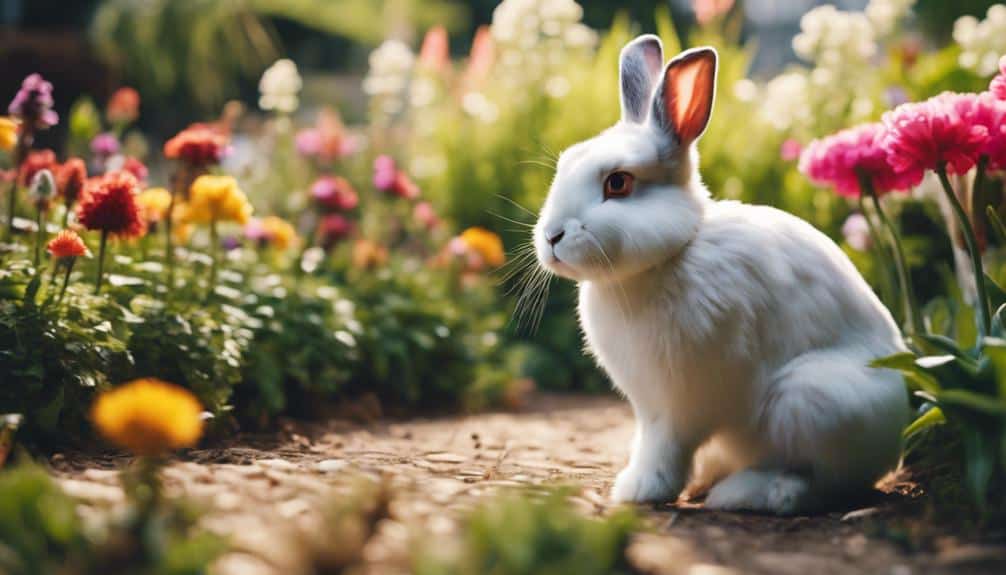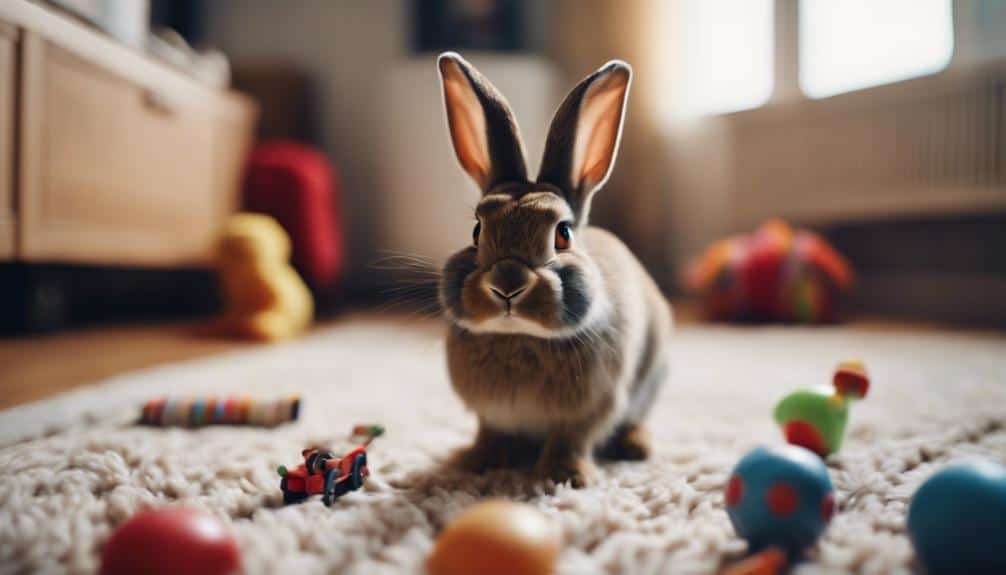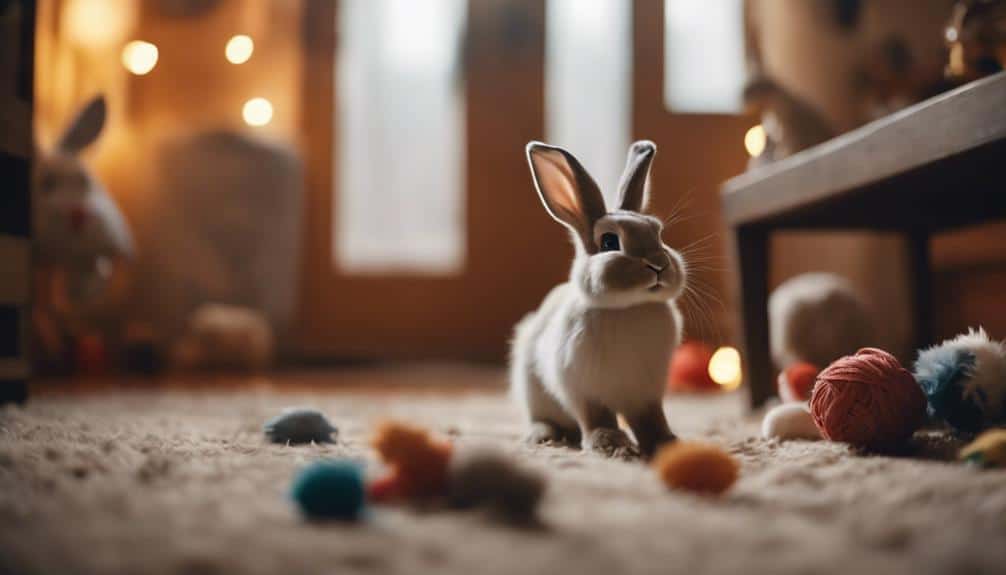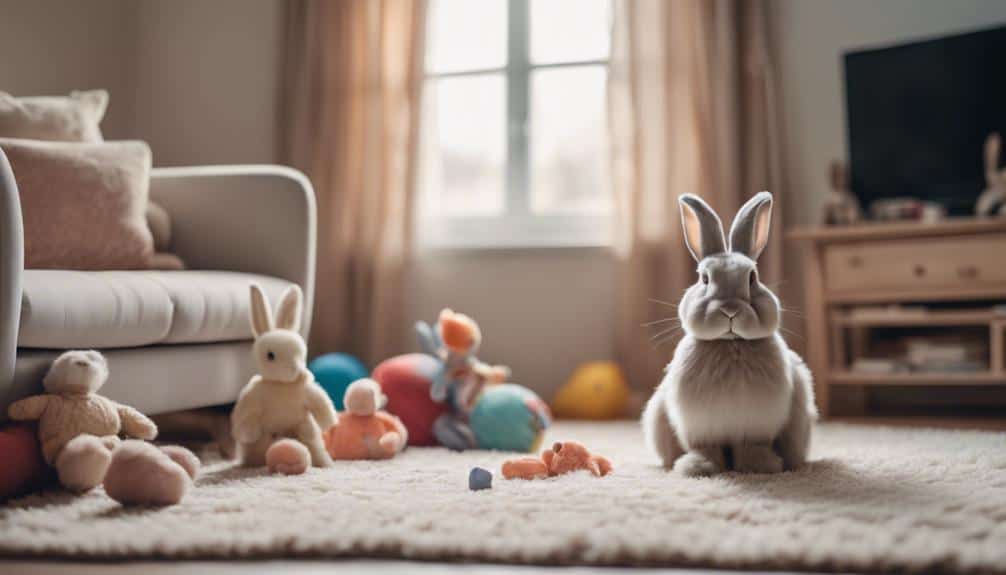Why Does My Pet Rabbit Thump?
Have you ever wondered why your pet rabbit suddenly thumps its hind legs? This thumping, often startling, isn’t just random behavior—it’s a crucial part of how rabbits communicate.
Thumping can indicate various emotions or reactions, from alerting others to potential danger to expressing excitement or territorial dominance. Understanding these signals can greatly enhance how you interact with and care for your rabbit.
So, what exactly triggers these thumping episodes, and how should you respond to them? Let’s explore the intriguing reasons behind your rabbit’s behavior.
Anatomy of Rabbit Thumping
When your pet rabbit thumps, it’s using a natural and powerful method of communication rooted in its anatomy and behavior. This distinctive behavior involves the rabbit drumming or stomping both of its hind feet on the ground, often in quick succession. The anatomy of a rabbit’s hind legs, which are strong and muscular, enables this loud and impactful thumping.
Your rabbit’s thumping is more than just noise; it’s a sophisticated language shaped by its environment and experiences. By understanding the triggers and context, you can better interpret what your rabbit is trying to convey. Rabbits might thump to alert others to potential danger, express discomfort, or even signal annoyance. Each thump is a deliberate action, influenced by the rabbit’s immediate surroundings and stimuli.
Interpreting this behavior requires paying close attention to your rabbit’s environment and any changes within it. Recognize what might be causing stress or unease, and you’ll be better equipped to respond appropriately. The thumping could also serve as a means of communication between rabbits or even with you, their human companion.
Through understanding and empathy, you can foster a sense of freedom and security for your pet.
Reasons for Thumping
Rabbits thump for several reasons, often to communicate perceived threats or send signals to other rabbits. By understanding these behaviors, you can better interpret your pet’s needs and emotional state.
Recognizing the reasons behind thumping helps you create a safer and more comfortable environment for your rabbit.
Perceived Threats
In many cases, your pet rabbit’s thumping is a reaction to perceived threats like predators or sudden loud noises in their environment. This behavior stems from their natural instinct to stay safe. When rabbits thump, they’re using a survival mechanism to communicate potential danger and signal to other rabbits to be on high alert.
Understanding these perceived threats can help you better manage your rabbit’s environment. Common triggers include sudden movements, unfamiliar scents, or changes in their surroundings. By identifying what specific disturbances are causing your rabbit to react, you can create a safer and more comfortable space for them.
Here are some potential reasons for thumping due to perceived threats:
- Sudden loud noises: Thunderstorms, fireworks, or household appliances can startle your rabbit.
- Predators: Even if they’re not visible, the scent or sound of a nearby predator can cause alarm.
- Unfamiliar scents: New smells in the environment can make your rabbit feel uneasy.
- Sudden movements: Quick or unexpected actions around your rabbit can be perceived as a threat.
- Changes in surroundings: Rearranging furniture or introducing new objects can disrupt their sense of security.
Communication Signals
Your pet rabbit’s thumping often serves as a multifaceted communication signal, conveying emotions such as excitement, fear, or a desire for attention. Thumping is a form of non-verbal communication that helps you understand your rabbit’s needs and intentions without words. By paying attention to the context and body language accompanying the thumps, you can decipher what your rabbit is trying to convey.
Rabbits use thumping to express a range of emotions and needs. For instance, a series of rapid thumps might indicate fear or anxiety, while isolated, louder thumps could signal a demand for attention or interaction. The intensity and frequency of the thumps also provide clues to your rabbit’s state of mind.
| Thumping Frequency | Possible Emotion or Need |
|---|---|
| Rapid, continuous | Fear or Anxiety |
| Slow, intermittent | Curiosity or Exploration |
| Single, loud | Attention or Interaction |
| Rhythmic, patterned | Excitement or Playfulness |
| Random, sporadic | Discomfort or Annoyance |
Understanding these communication signals can deepen your bond with your rabbit. By responding appropriately to their non-verbal cues, you make sure they feel secure and understood. Remember, each rabbit is unique, so observe their individual patterns and preferences to better meet their emotional and interaction needs.
Thumping as Communication

Ever wondered why your pet rabbit thumps its hind legs so significantly? Thumping is an important form of communication for rabbits, allowing them to express a range of emotions and needs. This behavior can indicate various states, from excitement to fear. Understanding thumping involves recognizing the context and body language accompanying it.
Rabbits often thump to grab your attention or to initiate interaction. If your rabbit thumps when you enter the room, it might be excited to see you or seeking your attention. Conversely, thumping can also be a sign of fear or unease, signaling a perceived threat in their environment.
Rabbits’ thumping isn’t just random; it’s a learned behavior that varies based on individual personalities. Some rabbits are more expressive, using thumps as a consistent form of communication, while others might do so sparingly. Recognizing what your rabbit is trying to convey can strengthen your bond and enhance your understanding of their emotional landscape.
Here’s a quick visual guide to why your rabbit might be thumping:
- Seeking attention
- Initiating interaction
- Expressing excitement
- Signaling fear
- Communicating with other rabbits or humans
Thumping in Fear
When rabbits thump out of fear, they’re instinctively alerting others to potential danger in their environment. This thumping serves as an important communication tool, signaling distress and anxiety. Loud noises, sudden movements, or perceived threats can trigger this instinctive behavior. When your rabbit feels unsafe or uncertain, it relies on thumping to convey its fear.
Understanding the causes behind this fear-induced thumping is crucial for ensuring your rabbit’s well-being. By identifying and minimizing these triggers, you can help create a safe and secure environment for your pet. For instance, reducing loud noises and sudden movements around your rabbit can greatly lower its anxiety levels. Providing a calm and stable environment will allow your rabbit to feel more secure and less prone to distress.
It’s important to approach your rabbit with empathy and patience, recognizing that its thumping is a natural defense mechanism. By offering reassurance and creating a safe habitat, you can help alleviate your rabbit’s fear and anxiety. In turn, this will foster a stronger bond and a more harmonious relationship between you and your pet.
Thumping in Excitement

Many rabbits thump out of sheer excitement, expressing their joy and enthusiasm through this lively behavior. When your rabbit is filled with excitement, you’ll notice an increase in their energy levels and playful behavior. Thumping in excitement is a positive sign that your rabbit is happy and enjoying their time. This behavior often accompanies activities like zooming around, binkying, or tossing toys across the room.
Understanding your rabbit’s individual preferences and the triggers that lead to excitement thumping can deepen your bond with them. By recognizing what makes your rabbit happiest, you can create an environment that fosters their well-being and joy.
Here are some common scenarios where you might observe excitement thumping:
- Playtime: Engaging in their favorite games or activities.
- New Toys: Introduction of new, stimulating toys.
- Food: Anticipation of a favorite treat or meal.
- Social Interaction: Playing with other rabbits or human companions.
- Exploring: Discovering new spaces or environments.
Territory and Dominance
Rabbits often thump as a way to assert dominance and establish their territory, making it important to understand this behavior for better interactions with your pet. When your rabbit thumps, it could be marking its boundaries, signaling other rabbits or even you to recognize its domain. This territorial behavior is more pronounced in unneutered or unspayed rabbits, as their instinct to assert dominance is stronger.
By thumping, rabbits communicate their need to mark their space, ensuring that others respect their boundaries. Understanding this can help you foster a more harmonious relationship with your pet. If your rabbit’s thumping seems aimed at you, it might be trying to assert its dominance over you, which is a natural part of their social structure.
Pay attention to these signals to improve your interactions. Respecting your rabbit’s territory and providing enough space can reduce the frequency of dominant thumping. Creating a comfortable environment where your rabbit feels secure can also help mitigate this behavior.
Thumping and Other Behaviors

When your rabbit thumps, it’s their way of communicating various emotions or needs. They might thump to warn you of perceived threats, express fear or displeasure, or even seek attention and playtime.
Understanding these behaviors helps you better respond to your rabbit’s unique signals and create a more comfortable environment for them.
Warning or Alarm Signals
Thumping is an instinctive behavior rabbits use to alert their group or humans to potential threats in their environment. When your rabbit thumps, it’s leveraging its natural survival instincts to communicate a sense of danger. This behavior can be triggered by a variety of stressors, including perceived predators, loud noises, or sudden movements. Understanding these alarm signals is important for ensuring your rabbit feels safe and secure.
Rabbits use thumping as an effective form of communication, warning others of possible threats. They might exhibit other signs of stress or discomfort alongside thumping, such as freezing or an increased heart rate. Paying attention to the context of the thumping—like the time of day or specific locations—can help you identify and mitigate the trigger causing the alarm.
Here are some key factors to keep in mind when your rabbit thumps:
- Predators: Even the sight or scent of a predator can trigger thumping.
- Loud Noises: Sudden, loud sounds can startle your rabbit, prompting them to thump.
- Sudden Movements: Unexpected movements in the environment can be perceived as threats.
- Stress Indicators: Look for other signs of stress, such as freezing.
- Communication: Thumping is an important way for rabbits to communicate potential risks.
Recognizing these alarm signals helps you create a safer, more peaceful environment for your rabbit.
Expressing Displeasure or Fear
While thumping often serves as a warning signal, it can also be a clear expression of displeasure or fear in your pet rabbit. When your rabbit feels anxious or stressed, it may thump to communicate its unease. Common triggers include loud noises, sudden movements, or changes in their routine. Recognizing these triggers is essential for improving your rabbit’s well-being.
Beyond thumping, your rabbit might exhibit other behaviors to signal distress. For example, ear positioning, body posture, or even vocalizations can accompany thumping to convey specific messages. By observing these signs, you can better understand your rabbit’s emotional state and take steps to alleviate its anxiety or stress.
Displeasure in rabbits can stem from various environmental or interaction-related factors. If your rabbit thumps during a specific activity or in a particular setting, it’s a clear indicator that something is causing discomfort. Addressing these issues promptly helps reduce their unease and improves their overall happiness.
Understanding the context behind your rabbit’s thumping allows you to make informed decisions to safeguard their well-being. By being attentive and responsive to your rabbit’s signals, you can create a more comfortable and stress-free environment for your furry friend.
Seeking Attention or Play
Many rabbits thump to grab your attention or to invite you to play. This behavior is often a form of communication, showing their desire for interaction and engagement.
If your rabbit is thumping, they’re likely seeking companionship or social interaction, indicating they want to bond with you.
Understanding your rabbit’s thumping can help you respond appropriately and strengthen your relationship.
Here are a few reasons why your rabbit might be thumping for attention or play:
- Seeking Interaction: Your rabbit may need some time with you, whether it’s petting, talking, or simply being near you.
- Inviting Play: Thumping can be a playful gesture, signaling that it’s time for some fun activities like chasing or exploring.
- Communication of Needs: Rabbits use thumping to let you know they want something, be it food, a toy, or just some company.
- Desiring Companionship: If your rabbit feels lonely, thumping might be their way of asking for a social connection.
- Strengthening the Bond: Responding to thumping can deepen the bond between you and your rabbit, leading to a more fulfilling companionship.
Responding to Thumping
When your rabbit starts thumping, respond calmly to avoid reinforcing the behavior. By maintaining a calm response, you help prevent the development of attention-seeking behavior. While it’s natural to want to comfort your rabbit immediately, overreacting can lead to more frequent thumping. Instead, offer gentle comfort and reassurance without making a big fuss.
Monitor the frequency and intensity of your rabbit’s thumping to better understand their communication. Sometimes, thumping indicates fear, stress, or a desire for attention. By observing patterns, you can discern what your rabbit is trying to convey. This monitoring behavior helps you address the root cause rather than just the symptom.
It’s also invaluable to seek experienced advice from rabbit owners or veterinarians. They can provide insights and strategies to manage thumping effectively. Remember, each rabbit is unique, and what works for one may not work for another.
Understanding your rabbit’s communication signals is key to avoiding reinforcement of unwanted behavior. By staying calm and collected, you create a reassuring environment. This approach not only comforts your pet but also respects their need for independence and freedom.
Preventing Excessive Thumping

To prevent excessive thumping, create a safe and secure environment that minimizes potential stressors. This involves understanding your rabbit’s needs and reducing environmental triggers that might cause anxiety or fear. Start by guaranteeing your rabbit’s enclosure is spacious and enriched with toys, hiding spots, and comfortable bedding to make them feel safe.
Regular interaction and socialization are vital to preventing loneliness and boredom, which can lead to thumping. Spend quality time with your rabbit daily, engaging in gentle play and grooming sessions. Additionally, positive reinforcement training can be effective in managing thumping behavior. Reward your rabbit with treats and praise when they remain calm, reinforcing the desired behavior.
Consider these steps to create a secure environment and manage thumping:
- Provide a spacious enclosure: Make sure your rabbit has enough room to move and explore.
- Reduce environmental triggers: Identify and eliminate sources of stress, such as loud noises or sudden movements.
- Implement positive reinforcement training: Use treats and praise to encourage calm behavior.
- Preventing loneliness: Regularly socialize your rabbit to keep them engaged and happy.
- Seek personalized advice: Consult with a rabbit-savvy veterinarian or animal behaviorist for tailored strategies.
Conclusion
By understanding why your rabbit thumps, you can better respond to its needs and emotions. Whether it’s signaling fear, excitement, or asserting dominance, your awareness helps strengthen your bond.
Pay attention to the context and other behaviors accompanying the thumping. With empathy and knowledge, you’ll guarantee your rabbit feels safe and understood, fostering a happier and healthier relationship.
Remember, your attentiveness can make a world of difference in your pet’s well-being.







